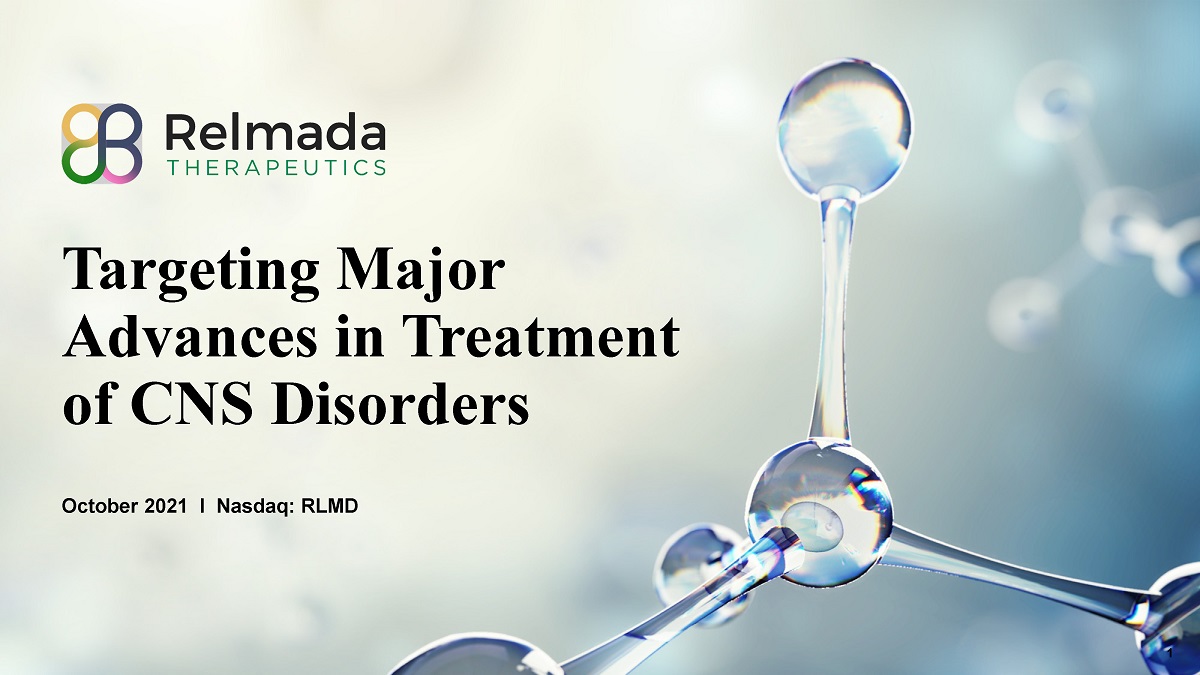
Exhibit 99.2

Targeting Major Advances in Treatment of CNS Disorders October 2021 I Nasdaq: RLMD 1
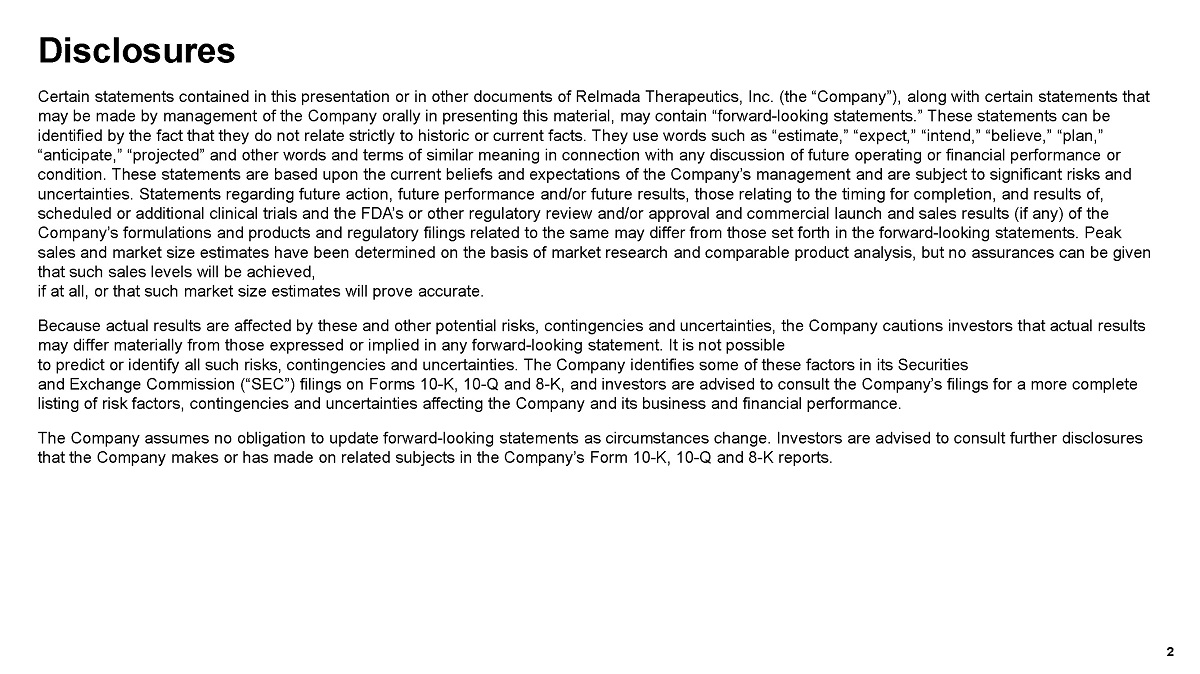
Disclosures Certain statements contained in this presentation or in other documents of Relmada Therapeutics, Inc. (the “Company”), along with certain statements that may be made by management of the Company orally in presenting this material, may contain “forward - looking statements.” These sta tements can be identified by the fact that they do not relate strictly to historic or current facts. They use words such as “estimate,” “exp ect ,” “intend,” “believe,” “plan,” “anticipate,” “projected” and other words and terms of similar meaning in connection with any discussion of future operating or financial performance or condition. These statements are based upon the current beliefs and expectations of the Company’s management and are subject t o s ignificant risks and uncertainties. Statements regarding future action, future performance and/or future results, those relating to the timing for completion, and results of, scheduled or additional clinical trials and the FDA’s or other regulatory review and/or approval and commercial launch and sa les results (if any) of the Company’s formulations and products and regulatory filings related to the same may differ from those set forth in the forward - lo oking statements. Peak sales and market size estimates have been determined on the basis of market research and comparable product analysis, but no ass urances can be given that such sales levels will be achieved, if at all, or that such market size estimates will prove accurate. Because actual results are affected by these and other potential risks, contingencies and uncertainties, the Company cautions in vestors that actual results may differ materially from those expressed or implied in any forward - looking statement. It is not possible to predict or identify all such risks, contingencies and uncertainties. The Company identifies some of these factors in its S ecu rities and Exchange Commission (“SEC”) filings on Forms 10 - K, 10 - Q and 8 - K, and investors are advised to consult the Company’s filings for a more complete listing of risk factors, contingencies and uncertainties affecting the Company and its business and financial performance. The Company assumes no obligation to update forward - looking statements as circumstances change. Investors are advised to consult further disclosures that the Company makes or has made on related subjects in the Company’s Form 10 - K, 10 - Q and 8 - K reports . 2
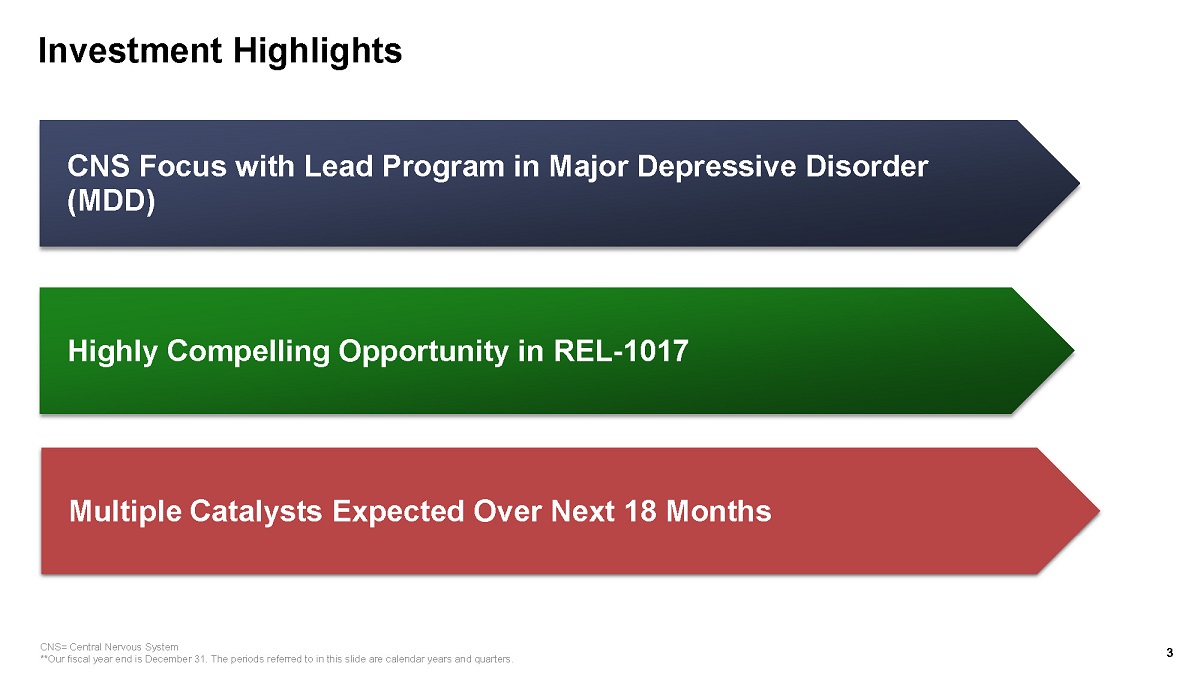
Investment Highlights Highly Compelling Opportunity in REL - 1017 Multiple Catalysts Expected Over Next 18 Months CNS Focus with Lead Program in Major Depressive Disorder (MDD) CNS= Central Nervous System **Our fiscal year end is December 31. The periods referred to in this slide are calendar years and quarters. 3
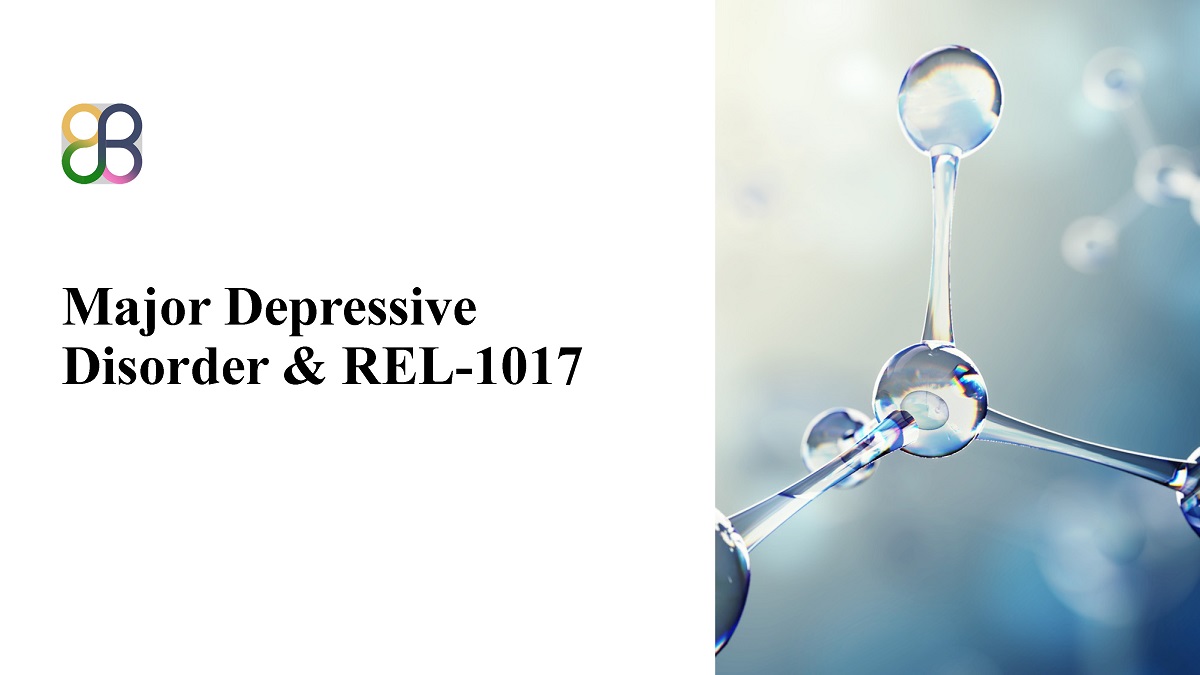
Major Depressive Disorder & REL - 1017
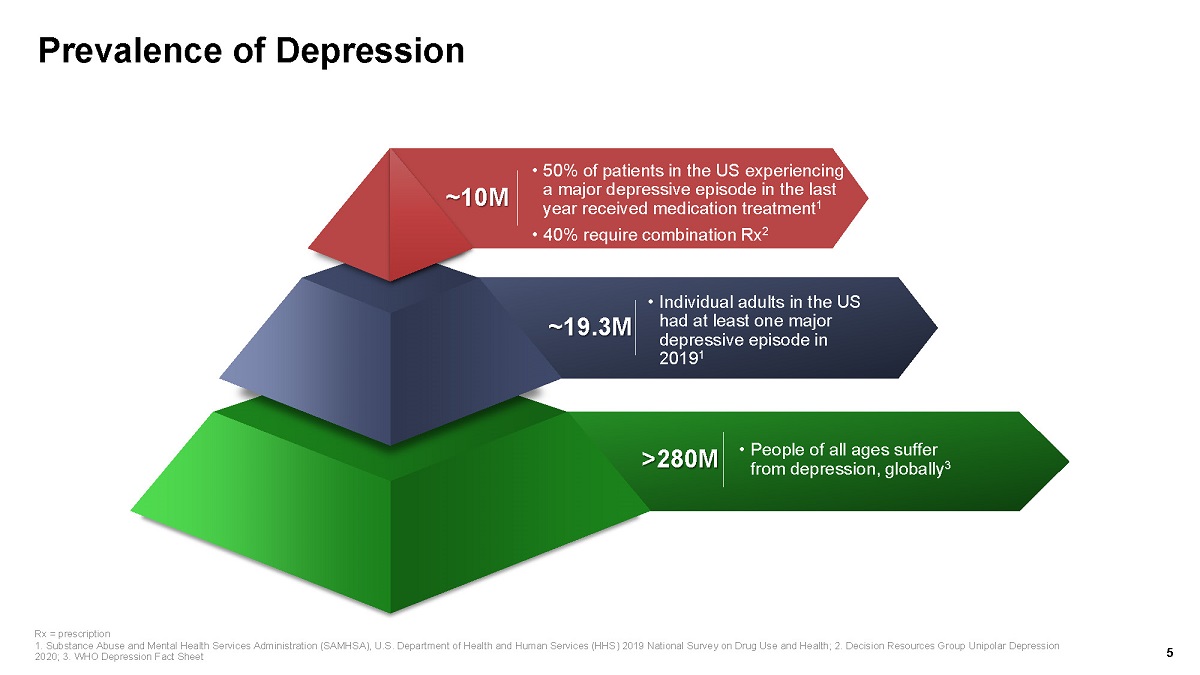
Prevalence of Depression ~10M • 50% of patients in the US experiencing a major depressive episode in the last year received medication treatment 1 • 40% require combination Rx 2 ~19.3M • Individual adults in the US had at least one major depressive episode in 2019 1 >280M • People of all ages suffer from depression, globally 3 5 Rx = prescription 1. Substance Abuse and Mental Health Services Administration (SAMHSA), U.S. Department of Health and Human Services (HHS) 201 9 N ational Survey on Drug Use and Health; 2. Decision Resources Group Unipolar Depression 2020; 3. WHO Depression Fact Sheet
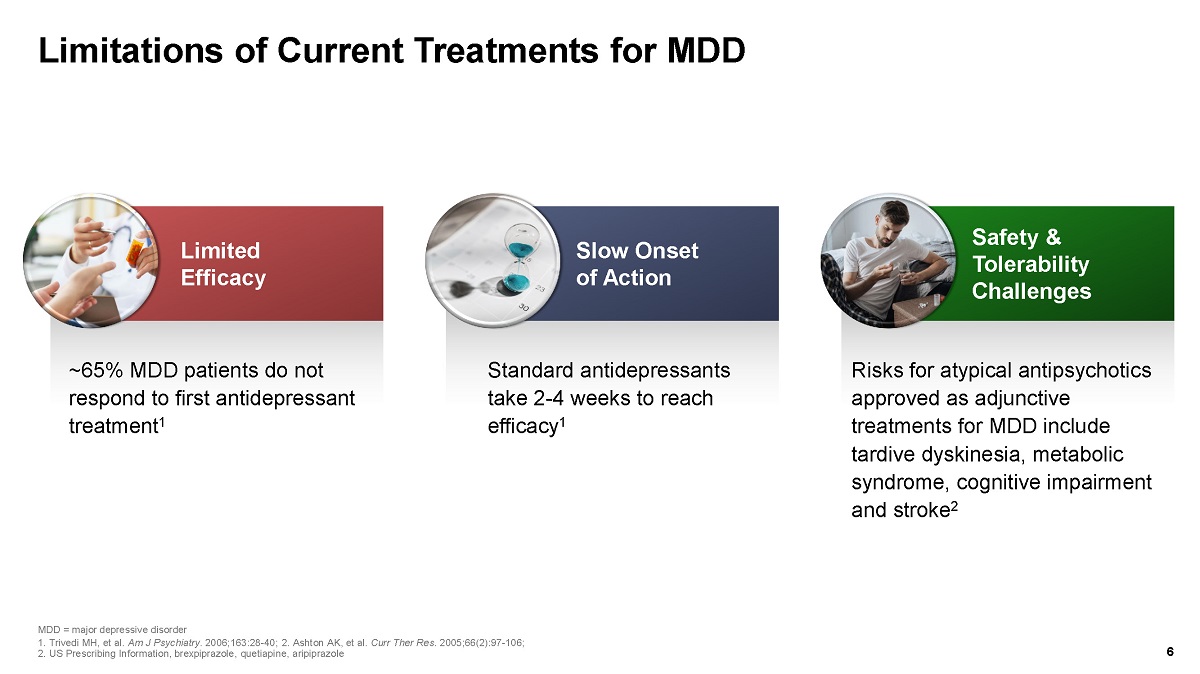
Limitations of Current Treatments for MDD ~65% MDD patients do not respond to first antidepressant treatment 1 Standard antidepressants take 2 - 4 weeks to reach efficacy 1 MDD = major depressive disorder 1. Trivedi MH, et al. Am J Psychiatry. 2006;163:28 - 40; 2. Ashton AK, et al. Curr Ther Res. 2005;66(2):97 - 106; 2. US Prescribing Information, brexpiprazole , quetiapine, aripiprazole 6 Slow Onset of Action Risks for atypical antipsychotics approved as adjunctive treatments for MDD include tardive dyskinesia, metabolic syndrome, cognitive impairment and stroke 2 Safety & Tolerability Challenges Limited Efficacy
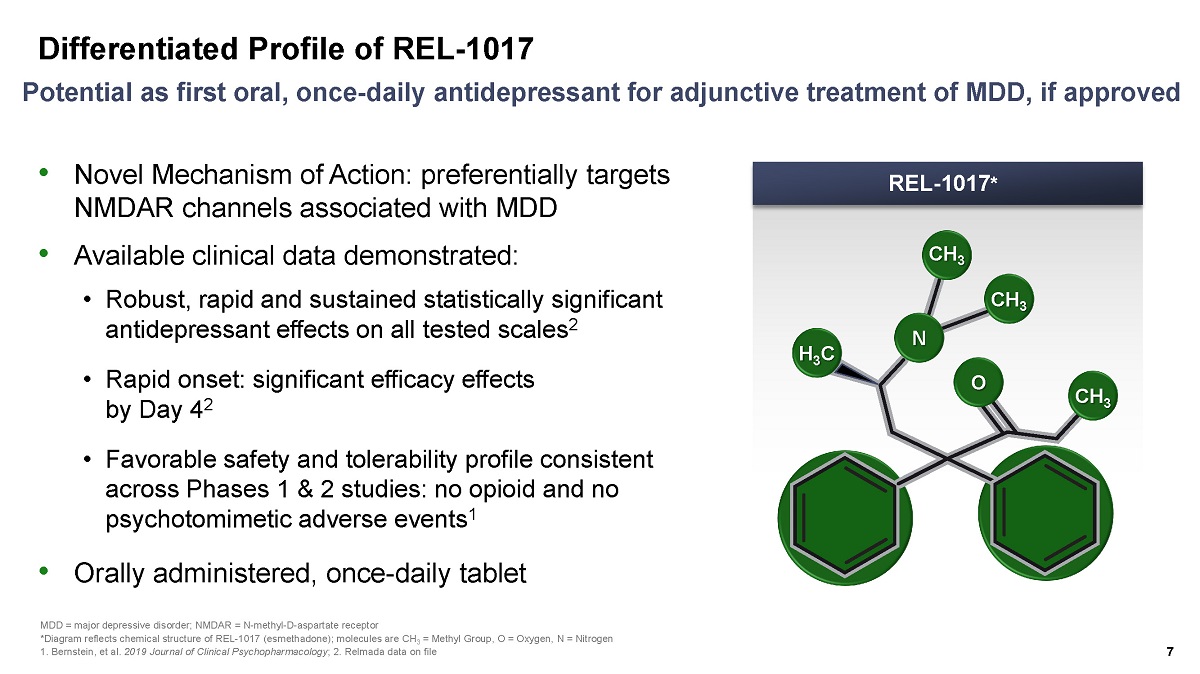
Differentiated Profile of REL - 1017 • Novel Mechanism of Action: preferentially targets NMDAR channels associated with MDD • Available clinical data demonstrated: • Robust, rapid and sustained statistically significant antidepressant effects on all tested scales 2 • Rapid onset: significant efficacy effects by Day 4 2 • Favorable safety and tolerability profile consistent across Phases 1 & 2 studies: no opioid and no psychotomimetic adverse events 1 • Orally administered, once - daily tablet 7 Potential as first oral, once - daily antidepressant for adjunctive treatment of MDD, if approved MDD = major depressive disorder; NMDAR = N - methyl - D - aspartate receptor *Diagram reflects chemical structure of REL - 1017 ( esmethadone ); molecules are CH 3 = Methyl Group, O = Oxygen, N = Nitrogen 1. Bernstein, et al. 2019 Journal of Clinical Psychopharmacology ; 2. Relmada data on file REL - 1017 * CH 3 CH 3 CH 3 O N H 3 C
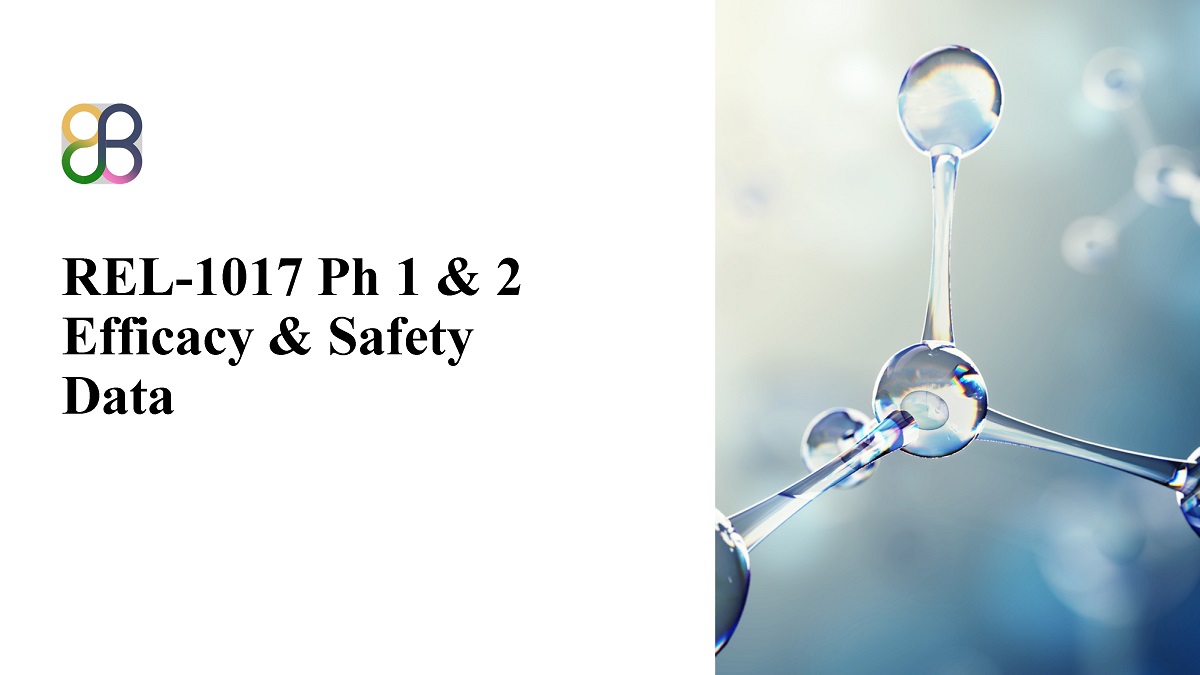
REL - 1017 Ph 1 & 2 Efficacy & Safety Data
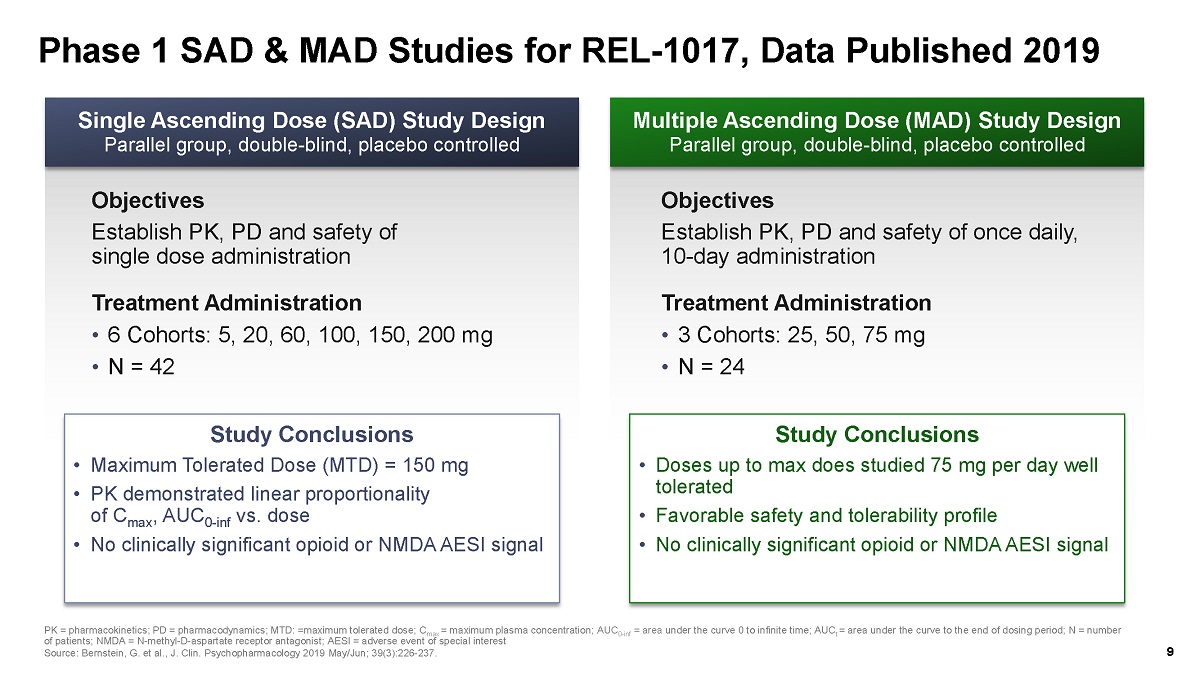
Phase 1 SAD & MAD Studies for REL - 1017, Data Published 2019 PK = pharmacokinetics; PD = pharmacodynamics; MTD: =maximum tolerated dose; C max = maximum plasma concentration ; AUC 0 - inf = area under the curve 0 to infinite time; AUC t = area under the curve to the end of dosing period; N = number of patients; NMDA = N - methyl - D - aspartate receptor antagonist; AESI = adverse event of special interest Source: Bernstein, G. et al., J. Clin. Psychopharmacology 2019 May/Jun; 39(3):226 - 237. Multiple Ascending Dose (MAD) Study Design Parallel group, double - blind, placebo controlled Single Ascending Dose (SAD) Study Design Parallel group, double - blind, placebo controlled Objectives Establish PK, PD and safety of single dose administration Treatment Administration • 6 Cohorts: 5, 20, 60, 100, 150, 200 mg • N = 42 Objectives Establish PK, PD and safety of once daily, 10 - day administration Treatment Administration • 3 Cohorts: 25, 50, 75 mg • N = 24 Study Conclusions • Maximum Tolerated Dose (MTD) = 150 mg • PK demonstrated linear proportionality of C max , AUC 0 - inf vs. dose • No clinically significant opioid or NMDA AESI signal Study Conclusions • Doses up to max does studied 75 mg per day well tolerated • Favorable safety and tolerability profile • No clinically significant opioid or NMDA AESI signal 9
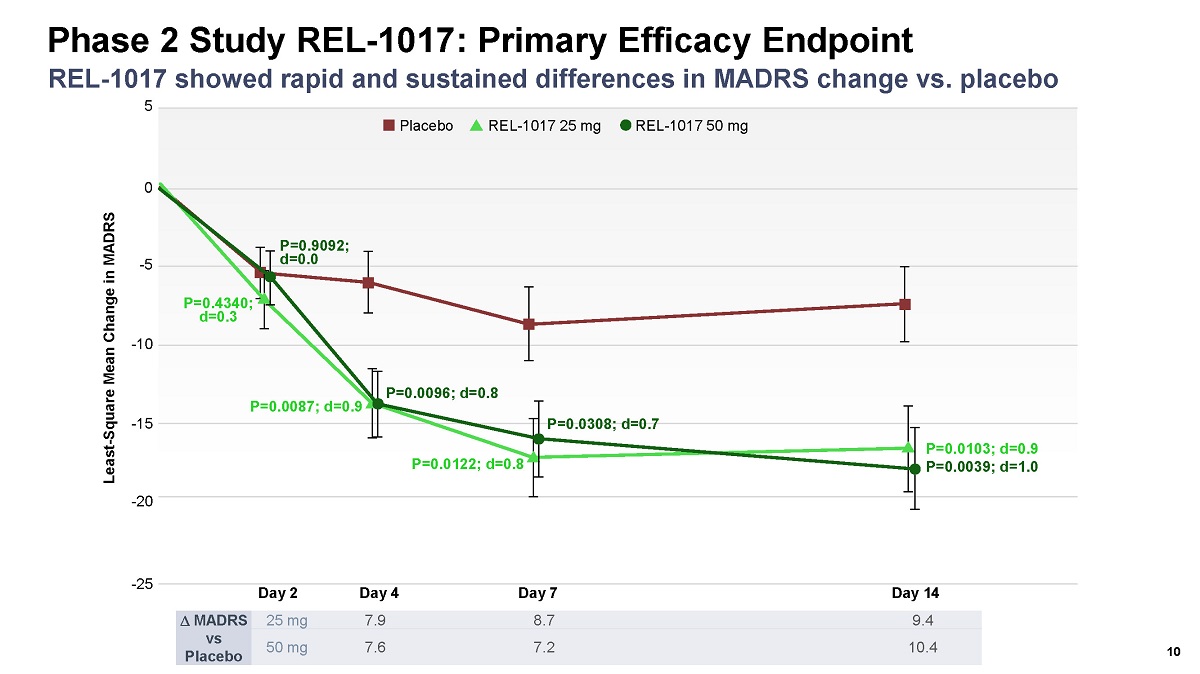
Day 2 Day 4 Day 7 Day 14 5 0 - 5 - 25 Least - Square Mean Change in MADRS - 10 - 15 - 20 P=0.0103; d=0.9 P=0.0039; d=1.0 P=0.0308; d=0.7 P=0.0122; d=0.8 P=0.0096; d=0.8 P=0.0087; d=0.9 P=0.9092; d=0.0 P=0.4340; d=0.3 Placebo REL - 1017 25 mg REL - 1017 50 mg Phase 2 Study REL - 1017: Primary Efficacy Endpoint 10 REL - 1017 showed rapid and sustained differences in MADRS change vs. placebo MADRS vs Placebo 25 mg 7.9 8.7 9.4 50 mg 7.6 7.2 10.4
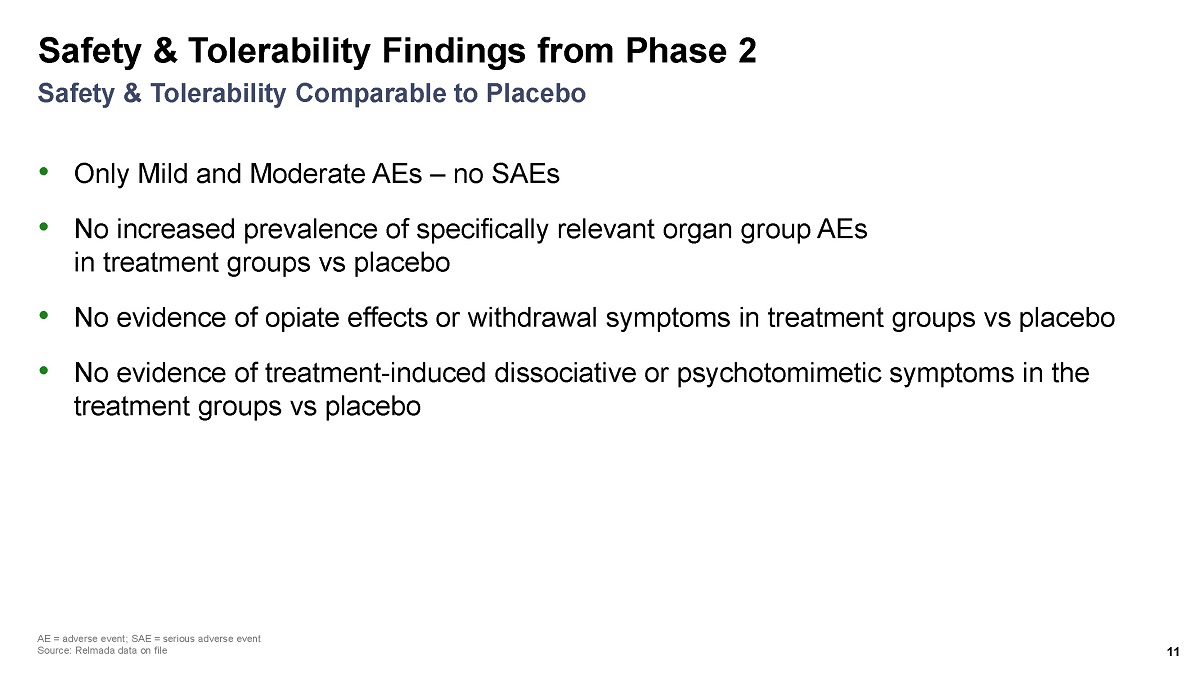
Safety & Tolerability Findings from Phase 2 • Only Mild and Moderate AEs – no SAEs • No increased prevalence of specifically relevant organ group AEs in treatment groups vs placebo • No evidence of opiate effects or withdrawal symptoms in treatment groups vs placebo • No evidence of treatment - induced dissociative or psychotomimetic symptoms in the treatment groups vs placebo 11 Safety & Tolerability Comparable to Placebo AE = adverse event; SAE = serious adverse event Source: Relmada data on file
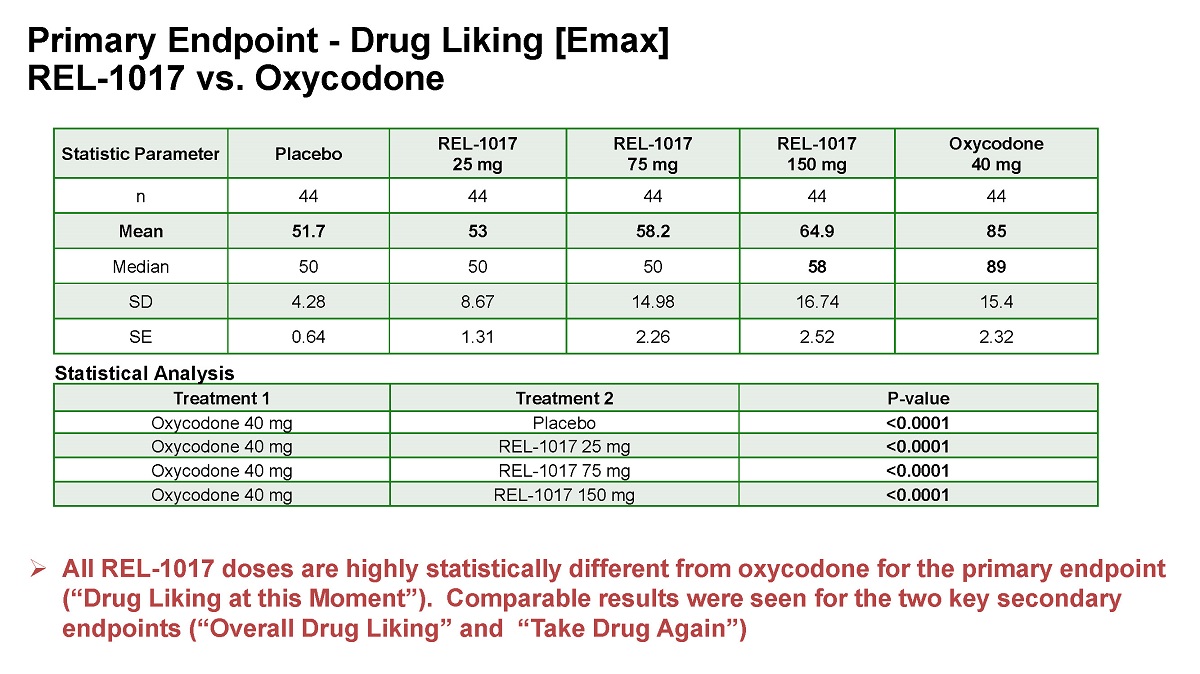
Primary Endpoint - Drug Liking [Emax] REL - 1017 vs. Oxycodone Statistic Parameter Placebo REL - 1017 25 mg REL - 1017 75 mg REL - 1017 150 mg Oxycodone 40 mg n 44 44 44 44 44 Mean 51.7 53 58.2 64.9 85 Median 50 50 50 58 89 SD 4.28 8.67 14.98 16.74 15.4 SE 0.64 1.31 2.26 2.52 2.32 Treatment 1 Treatment 2 P - value Oxycodone 40 mg Placebo <0.0001 Oxycodone 40 mg REL - 1017 25 mg <0.0001 Oxycodone 40 mg REL - 1017 75 mg <0.0001 Oxycodone 40 mg REL - 1017 150 mg <0.0001 Statistical Analysis » All REL - 1017 doses are highly statistically different from oxycodone for the primary endpoint (“Drug Liking at this Moment”). Comparable results were seen for the two key secondary endpoints (“Overall Drug Liking” and “Take Drug Again”)
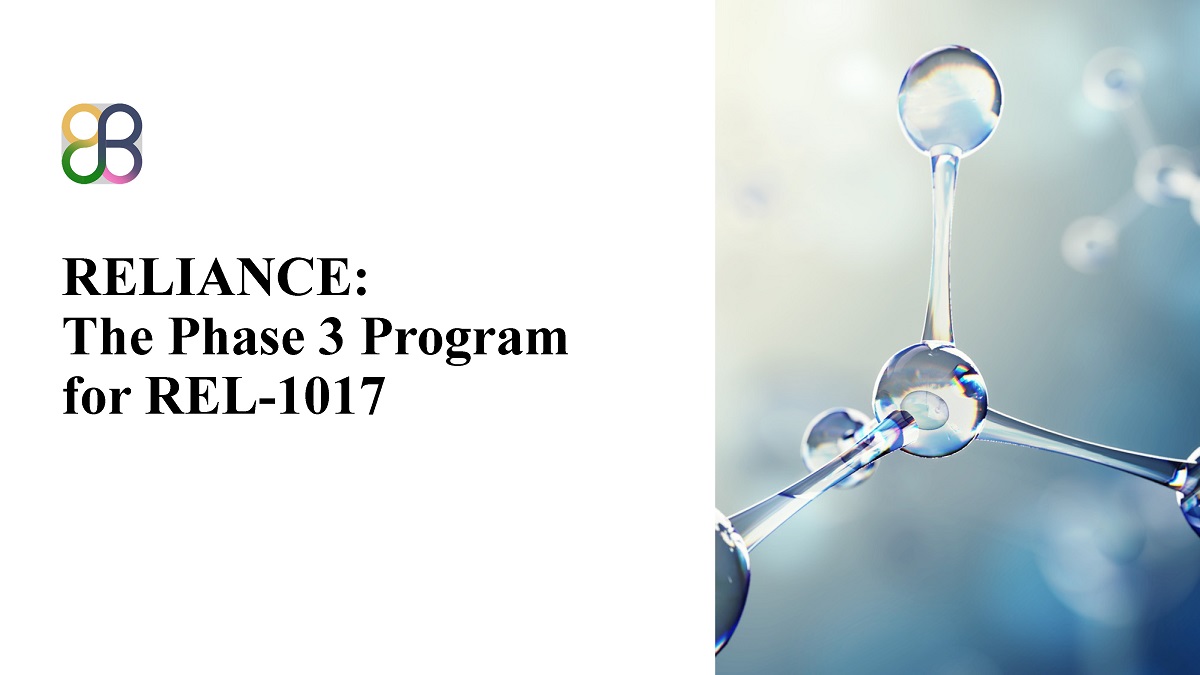
RELIANCE: The Phase 3 Program for REL - 1017
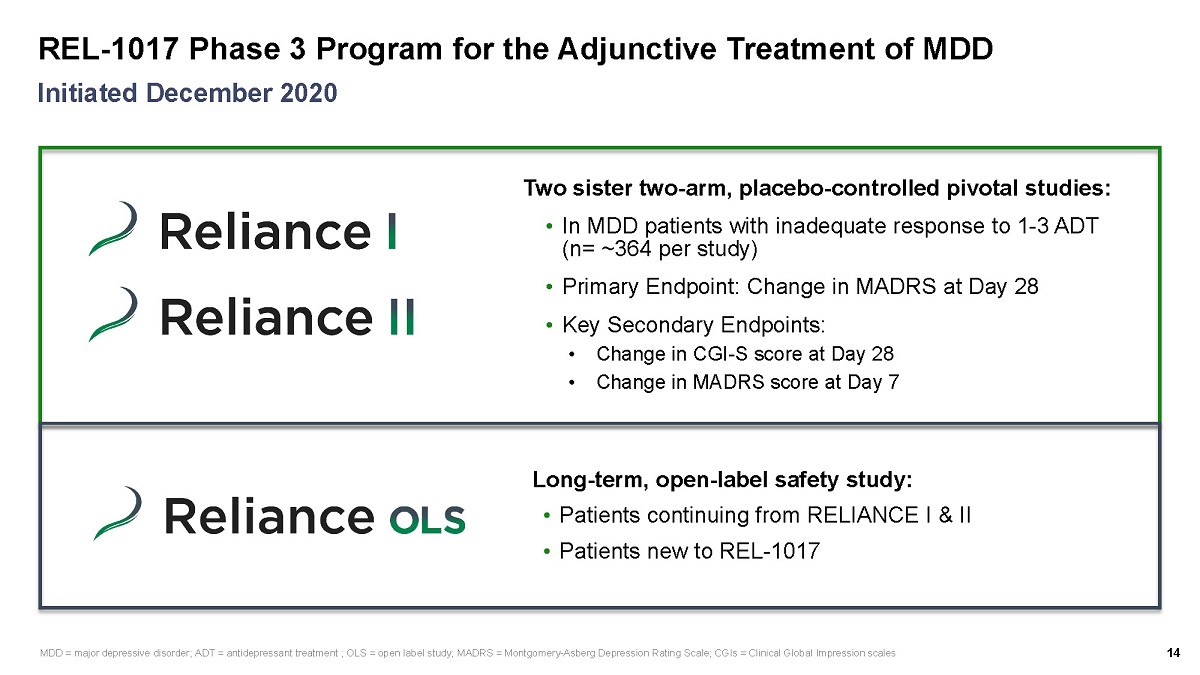
REL - 1017 Phase 3 Program for the Adjunctive Treatment of MDD 14 Initiated December 2020 Two sister two - arm, placebo - controlled pivotal studies: • In MDD patients with inadequate response to 1 - 3 ADT (n= ~364 per study) • Primary Endpoint: Change in MADRS at Day 28 • Key Secondary Endpoints: • Change in CGI - S score at Day 28 • Change in MADRS score at Day 7 Long - term, open - label safety study: • Patients continuing from RELIANCE I & II • Patients new to REL - 1017 MDD = major depressive disorder; ADT = antidepressant treatment ; OLS = open label study; MADRS = Montgomery - Asberg Depression Rating Scale; CGIs = Clinical Global Impression scales
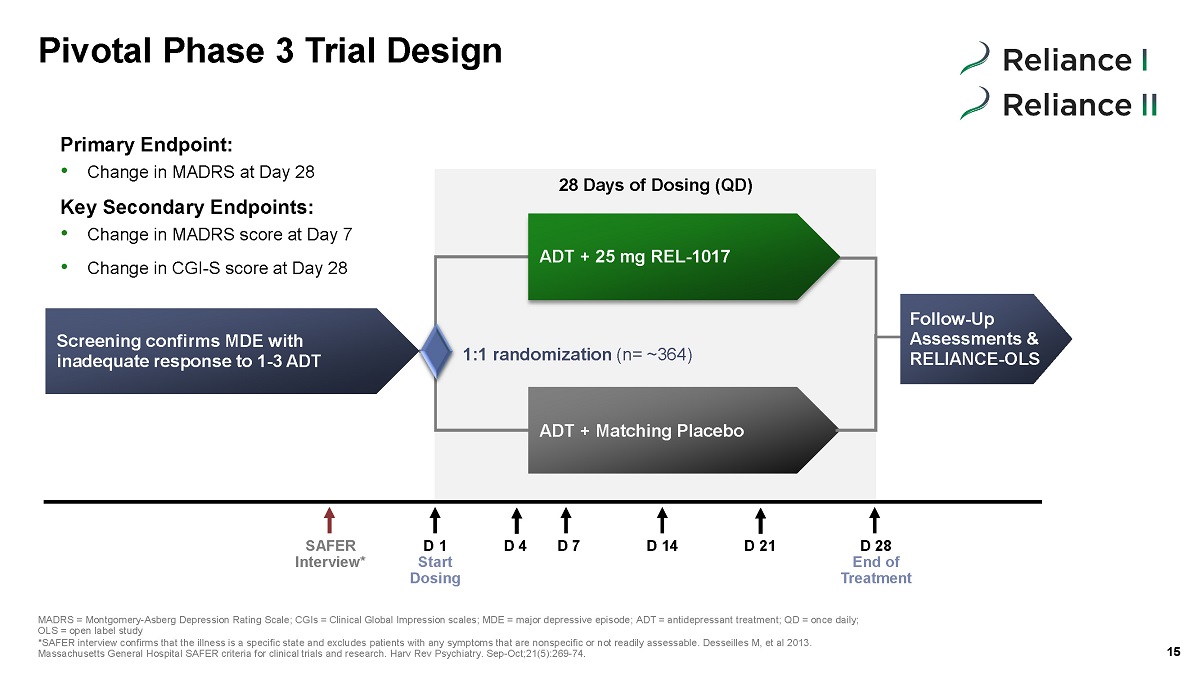
Screening confirms MDE with inadequate response to 1 - 3 ADT ADT + 25 mg REL - 1017 ADT + Matching Placebo Pivotal Phase 3 Trial Design 15 Primary Endpoint: • Change in MADRS at Day 28 Key Secondary Endpoints: • Change in MADRS score at Day 7 • Change in CGI - S score at Day 28 1:1 randomization (n= ~ 364 ) 28 Days of Dosing (QD) Follow - Up Assessments & RELIANCE - OLS SAFER Interview* D 1 Start Dosing D 4 D 7 D 14 D 28 End of Treatment D 21 MADRS = Montgomery - Asberg Depression Rating Scale; CGIs = Clinical Global Impression scales; MDE = major depressive episode; ADT = antidepressant treat me nt; QD = once daily; OLS = open label study *SAFER interview confirms that the illness is a specific state and excludes patients with any symptoms that are nonspecific o r n ot readily assessable. Desseilles M, et al 2013. Massachusetts General Hospital SAFER criteria for clinical trials and research. Harv Rev Psychiatry. Sep - Oct;21(5):269 - 74.
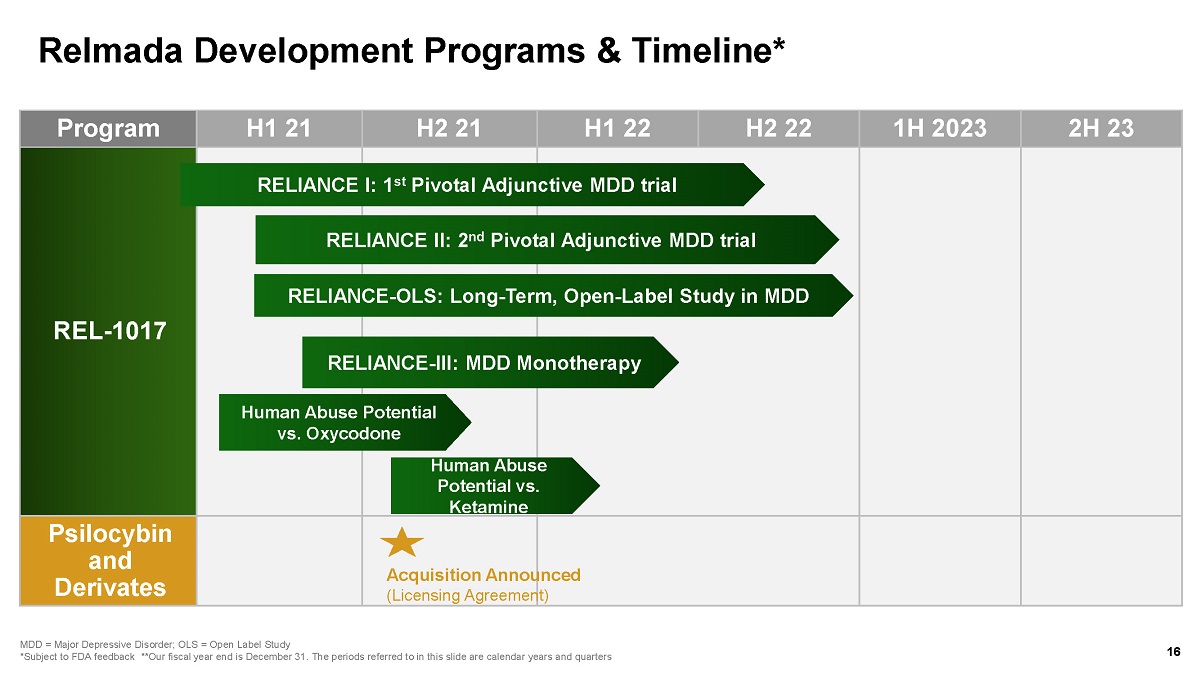
Relmada Development Programs & Timeline* Program H1 21 H2 21 H1 22 H2 22 1H 2023 2H 23 REL - 1017 Psilocybin and Derivates RELIANCE - III: MDD Monotherapy RELIANCE I: 1 st Pivotal Adjunctive MDD trial RELIANCE II: 2 nd Pivotal Adjunctive MDD trial RELIANCE - OLS: Long - Term, Open - Label Study in MDD 16 MDD = Major Depressive Disorder; OLS = Open Label Study *Subject to FDA feedback **Our fiscal year end is December 31. The periods referred to in this slide are calendar years and qua rters Human Abuse Potential vs. Ketamine Human Abuse Potential vs. Oxycodone Acquisition Announced (Licensing Agreement)
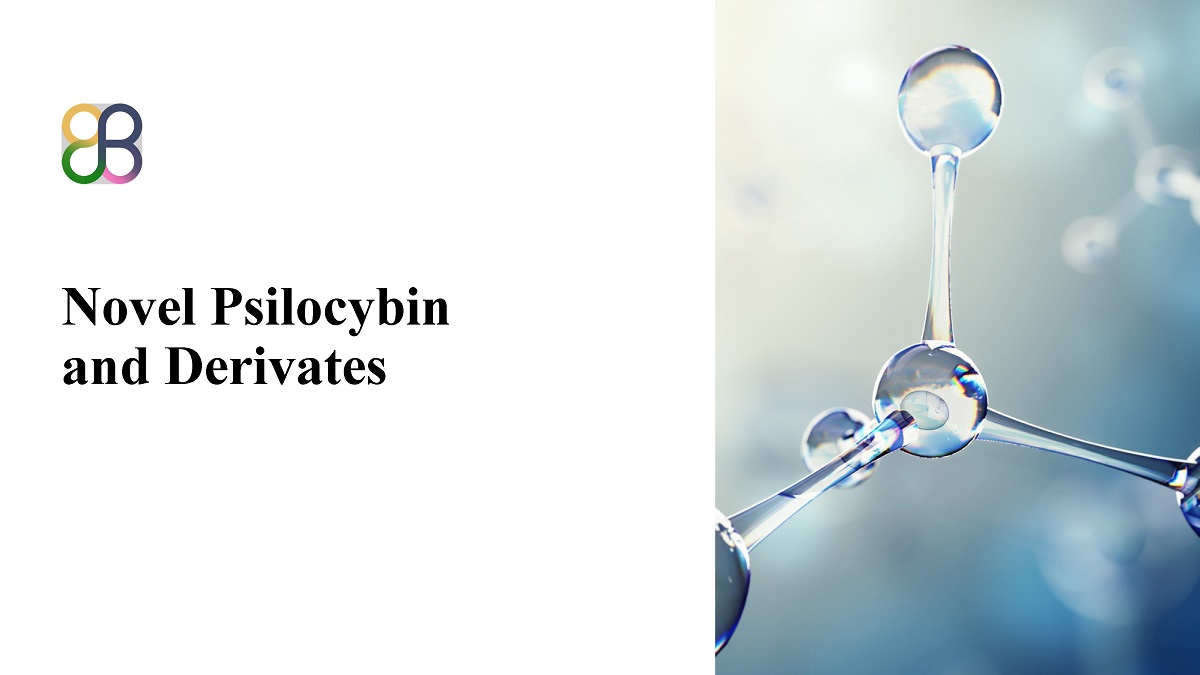
Novel Psilocybin and Derivates
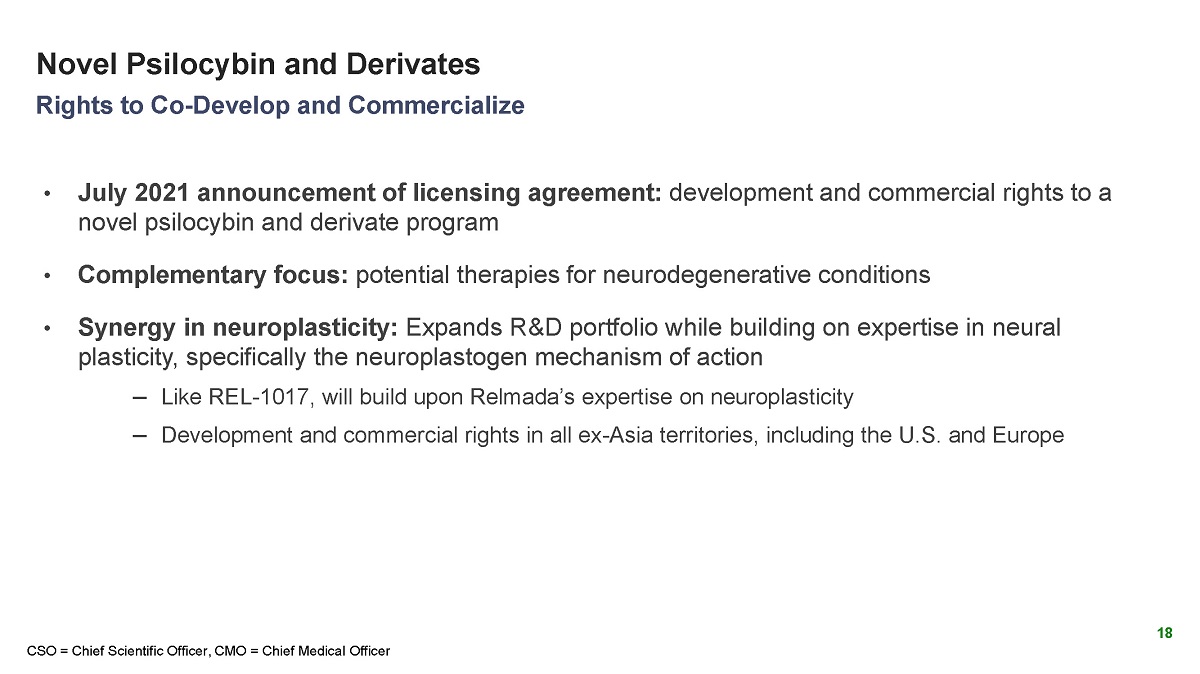
Novel Psilocybin and Derivates • July 2021 announcement of licensing agreement: development and commercial rights to a novel psilocybin and derivate program • Complementary focus: potential therapies for neurodegenerative conditions • Synergy in neuroplasticity: Expands R&D portfolio while building on expertise in neural plasticity, specifically the neuroplastogen mechanism of action – Like REL - 1017, will build upon Relmada’s expertise on neuroplasticity – Development and commercial rights in all ex - Asia territories, including the U.S. and Europe Rights to Co - Develop and Commercialize 18 CSO = Chief Scientific Officer, CMO = Chief Medical Officer

Corporate Information
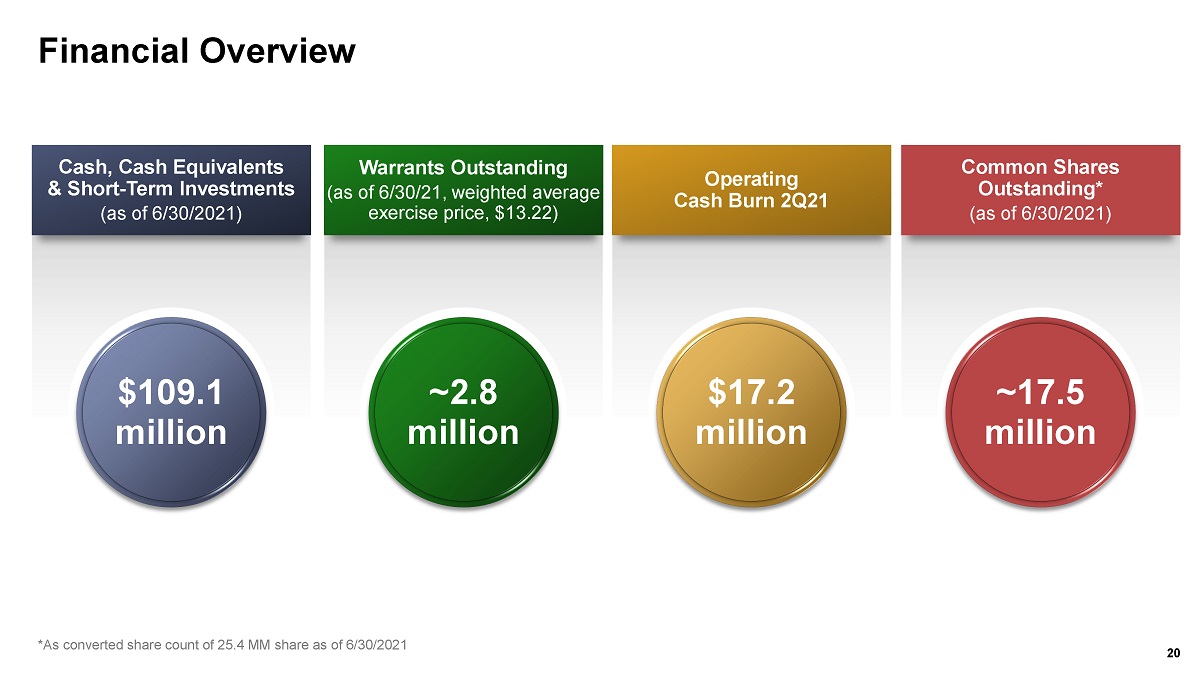
Financial Overview Cash, Cash Equivalents & Short - Term Investments (as of 6/30/2021) $109.1 million Warrants Outstanding (as of 6/30/21, weighted average exercise price, $13.22) ~2.8 million Operating Cash Burn 2Q21 $17.2 million Common Shares Outstanding* (as of 6/30/2021) ~17.5 million 20 *As converted share count of 25.4 MM share as of 6/30/2021
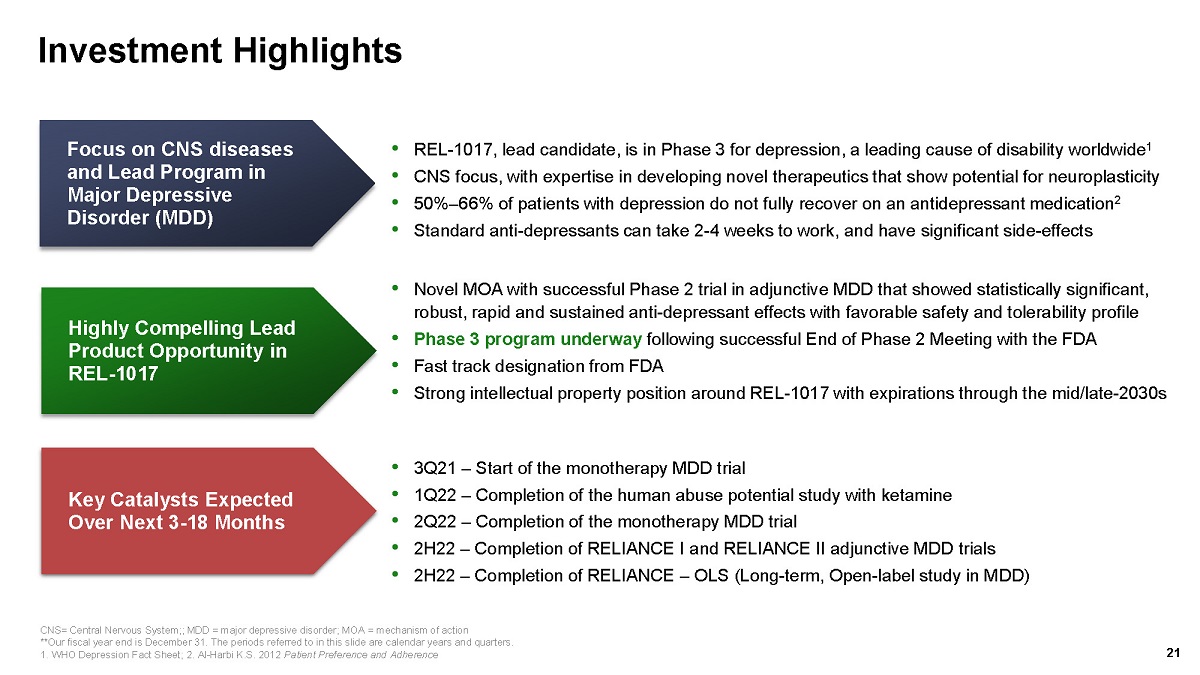
Investment Highlights Highly Compelling Lead Product Opportunity in REL - 1017 Key Catalysts Expected Over Next 3 - 18 Months Focus on CNS diseases and Lead Program in Major Depressive Disorder (MDD) CNS= Central Nervous System;; MDD = major depressive disorder; MOA = mechanism of action **Our fiscal year end is December 31. The periods referred to in this slide are calendar years and quarters. 1. WHO Depression Fact Sheet; 2. Al - Harbi K.S. 2012 Patient Preference and Adherence 21 • Novel MOA with successful Phase 2 trial in adjunctive MDD that showed statistically significant, robust, rapid and sustained anti - depressant effects with favorable safety and tolerability profile • Phase 3 program underway following successful End of Phase 2 Meeting with the FDA • Fast track designation from FDA • Strong intellectual property position around REL - 1017 with expirations through the mid/late - 2030s • REL - 1017, l ead candidate, is in Phase 3 for depression, a leading cause of disability worldwide 1 • CNS focus, with expertise in developing novel therapeutics that show potential for neuroplasticity • 50% – 66% of patients with depression do not fully recover on an antidepressant medication 2 • Standard anti - depressants can take 2 - 4 weeks to work, and have significant side - effects • 3 Q21 – Start of the monotherapy MDD trial • 1Q22 – Completion of the human abuse potential study with ketamine • 2 Q22 – Completion of the monotherapy MDD trial • 2 H22 – Completion of RELIANCE I and RELIANCE II adjunctive MDD trials • 2H22 – Completion of RELIANCE – OLS (Long - term, Open - label study in MDD)
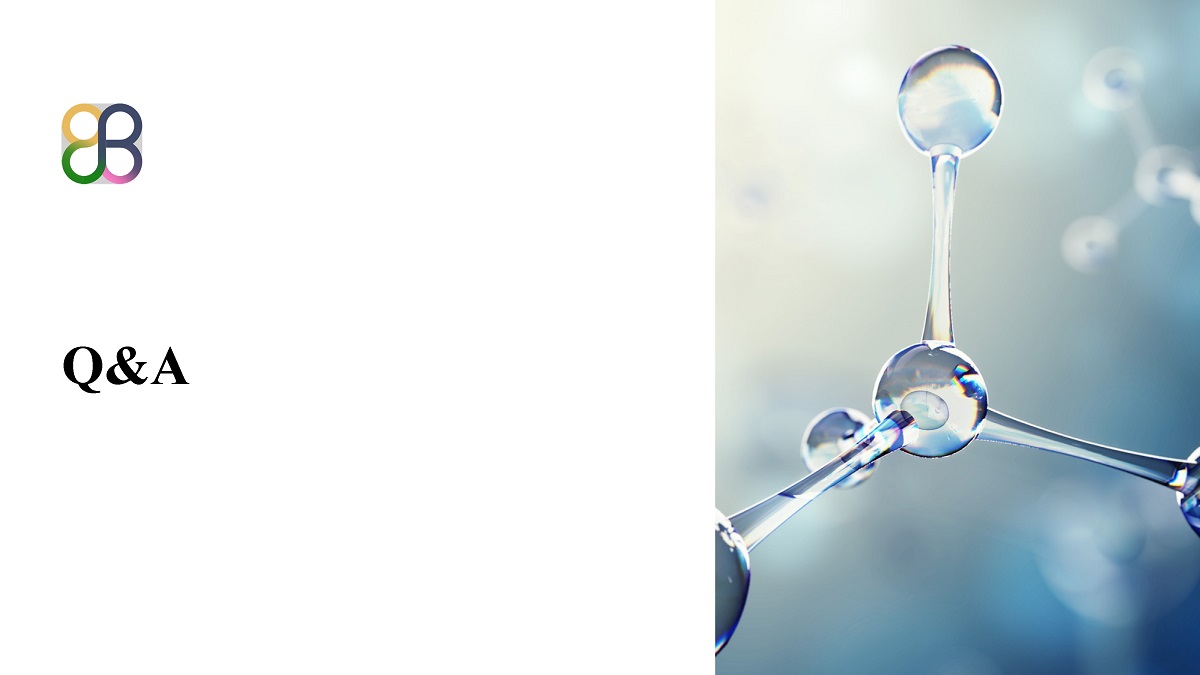
Q&A